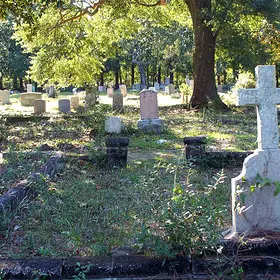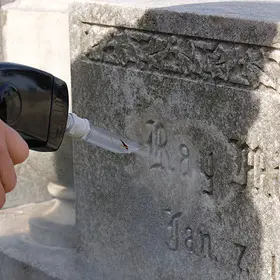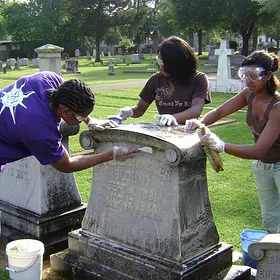A Personal Journey Through African-American Cemeteries
I’ll never forget the exciting moment when I found the gravesite of Alexander Orton, my paternal great-great-great-grandfather. Born in 1842 in Virginia, he was a Civil War veteran and member of the 10th Regiment, U. S. Colored Infantry.
Finding his last resting place was part of a genealogy project I've been pursuing for nine years now, keeping a long-standing promise made to an elder. Diagnosed with a serious chronic illness as a teenager, I needed a kidney transplant soon after college. My great-aunt gathered her entire church congregation to support my transplant fund, but held a lingering concern about our family legacy.

The author at the gravesite of her great-great-great-grandfather Alexander Orton, 10th U. S. Colored Infantry, at Grove Baptist Church Cemetery in Portsmouth, Virginia.
“Do not let our history die,” she told my father shortly before her passing in 2007. To honor her last wish, I vowed to make the most of my second chance and do my part in documenting our family history.
I’ve traced my father’s ancestry to 1630 in Virginia, and my mother’s to 1770 in North Carolina. Some of my ancestors were born free, while others were enslaved. Like Alexander, some enlisted in the Union Army to fight for freedom in the Civil War. They’d founded four African-American communities in Tidewater, Virginia, along with masonic lodges, banks, churches, and schools. They were oystermen, carpenters, farmers, teachers, Pullman porters, and teamsters at the Norfolk Naval Shipyard.

Slave cemetery in North Carolina.
This search for family history has led me to various cemeteries throughout Tidewater Virginia and North Carolina. I’ve visited Petersburg’s Poplar Grove National Cemetery, where an ancestor who died during the Siege of Petersburg is buried in one of the over 4,000 “unknown” graves. We have relatives buried in the cemeteries of Evergreen, East End, and Oakwood, in Richmond, Virginia, the city where a distant ancestor was sold in the city’s slave market in 1831 in Shockoe Bottom, the same city my father came to call home by 1958.
In Norfolk City, Civil War veteran ancestors are buried in historic West Point Cemetery and Calvary Cemetery. In Portsmouth, Virginia, ancestors are interred in Mount Calvary, Mount Olive, Lincoln Memorial, and Grove Baptist Church cemeteries. And in North Carolina, we found the location of a slave cemetery containing the burials of some of our earliest known maternal ancestors.
In 2010, I began documenting my work in social media through Facebook pages, Instagram, Twitter, a website and blog, and contributions to the online community Find-a-Grave. Through these sites, I’ve met other descendants, also curious about their ancestors’ final resting places. In 2014, I was privileged to help two descendants find the grave of their Civil War ancestor. One was celebrating his eighty-eighth birthday, and I was happy to assist him in the effort to secure a replacement gravestone from the Department of Veterans Affairs. I blogged about the experience, on witnessing how history can become a tangible thing, as the men discussed their mutual family history while standing at the gravesite.

Danville National/Green Hill/Freedman's Cemetery in Danville, Virginia
Though I’d learned about my family history from various documentary sources, the cemeteries remained primary in my research. They were the only historical sites left in many cases, as most of the other institutions my ancestors founded no longer existed. They’d been demolished or razed for freeway construction and urban renewal projects in the 1960s. The communities they’d founded, against all odds, some over a century old, were gone. And as the residents of these communities were removed or displaced, due to gentrification or eminent domain, the cemeteries became isolated. Family visitation ceased, and these historic sites appeared to become neglected and abandoned.
As stated on my website in 2011, it is in this way that the cemeteries remained some of the last vestiges of a community’s very existence, of its accomplishments and contributions to the social and historical fabric of our country.
This sobering reality is shared by a majority of African and African-American historical burial grounds. I’ve visited nearly 300 of these sites over the last seven years, and seen firsthand how they’re threatened daily by commercial development, gentrification, overgrowth, rampant flooding, trash collection, and vandalism.
Some were segregated by race, as can be seen with the intersection of Freedman’s, Green Hill, and Danville National cemeteries in Danville, Virginia. Overgrowth made some virtually inaccessible, like Richmond, Virginia’s East End and Evergreen cemeteries, Baltimore, Maryland’s Mount Auburn Cemetery, and Charlotte, North Carolina’s Cedar Grove Cemetery. I’d seen freeway construction supplant other cemeteries, such as Gilbert Memorial in Atlanta, Georgia. All that remains of the historic cemetery are about fifty gravestones, completely surrounded by Interstate 95 and an access ramp.
Preservation Leadership Forum: Recovering and Preserving African-American Cemeteries

African-American burial grounds have become endangered sites of our collective heritage. Learn what led to their neglect and how we can make up for lost time.

Gilbert Memorial Cemetery in Atlanta, Georgia.
Other cemeteries were relocated. In Wilmington, North Carolina, Flemington-Oak Grove Cemetery was moved from 17th Street to a sandy patch of ground at the end of Sampson Street, for a road construction project. However, historians estimate that many of the 10,000+ burials remain in their original location. In order to visit the new site on Sampson, one must cross railroad tracks, several industrial sites, and a row of portable toilets. A rusted gate and lock appear to discourage visitation, and on the day of my visit in 2015, there was no directional signage to the cemetery, fifty-three years after the relocation.

Flemington-Oak Grove Cemetery in Wilmington, North Carolina.
Over the years, I’ve come to truly understand and appreciate the rich history that can be found in African-American cemeteries, and how they can help in the discovery of one's ancestors. But the stories in the stones may be lost as the threats to them increase.
These historic sites matter; they merit our respect and protection. I will continue to tell the stories of the many family legacies I find interred in these sites, following the trail illuminated by genealogical records, and incorporating the oral histories imparted by elders and members of the community. The ancestors are speaking, and I’m listening.
Preservation Tips & Tools: 10 Tips for Researching Historic Cemeteries and Burial Grounds

Cemeteries can provide strong and direct links to our past. This toolkit will help you start digging (figuratively) into their history.
Preservation Tips & Tools: How to Preserve Historic Cemeteries and Burial Grounds

Have you researched your cemetery's past? Ready to start preserving it? Here are tips for how and where to start.


